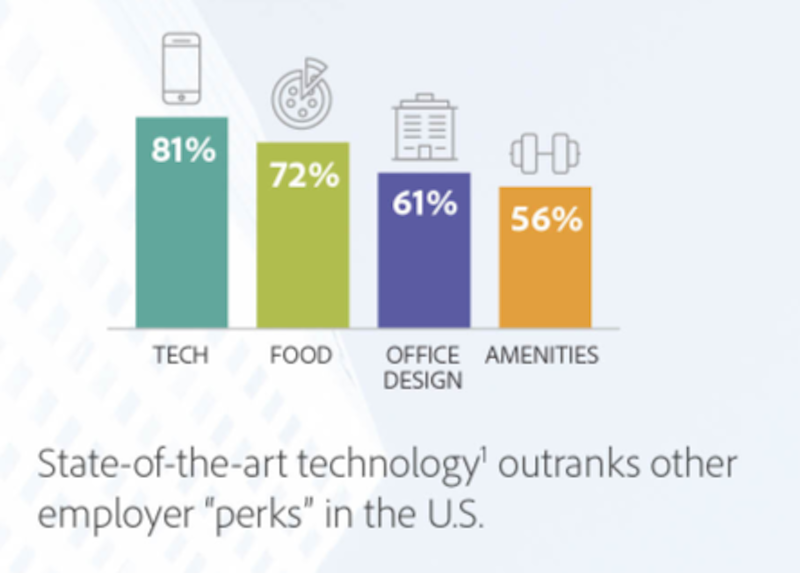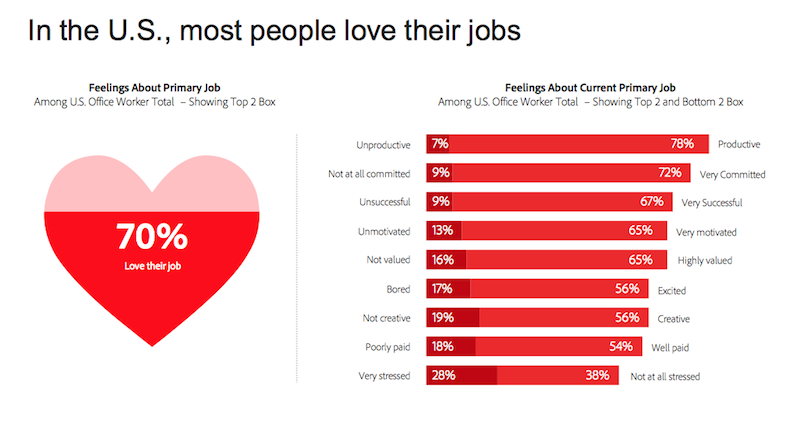American office workers love their jobs, and love them even more when the technology their companies use is viewed as being ahead of the curve.
A recent online survey of more than 1,000 office workers in the U.S., which Adobe conducted during two weeks last month, finds 70% saying they love what they do. And a remarkable 81% say that state-of-the-art technology was more important to them than an office’s design or on-site amenities.
Seven out of 10 U.S. workers believe technology improves the work-life balance, and 81% say technology helps them connect with colleagues more efficiently. Those respondents who think their company’s technology is “ahead of the curve” feel about twice as creative, motivated, and satisfied as respondents who work for companies with less-than-cutting edge technology.
The rub is that only 25% of the survey’s U.S. respondents think their company’s technology excels. Nevertheless, more than half (53%) expects technology to be handling more of their offices’ menial tasks—copying, filing, etc.—over the next two decades, even as 55% remain convinced their jobs could never be replaced by a machine.
In fact, there seems to be more than a hint of ambivalence about the benefits of technology among the 75% of respondents who are concerned that relationships and health suffer when people become to attached to their devices.

Technology trumps other office amenities in what keeps workers content. Image: Adobe's “Work in Progress” report.
The Adobe survey portrays an American workforce for which work and life are inseparable, almost to the point of obsession. More than half of the respondents say they’d keep working if they won the lottery. U.S. workers say they spend, on average, 78% of their waking hours during the work week and 41% of their days off thinking about their jobs. Indeed, 57% of respondents agree with the statement “work defines who I am.”
The desire to work is further punctuated by the finding that one in three U.S. office workers moonlights in jobs outside of his or her primary occupation, and that moonlighters are more likely to be happier and more optimistic than non-moonlighters.
However, 69% of U.S. workers also say they work multiple jobs because they need the money. Nearly three-fifths of American workers are likely to leave their jobs for a better opportunity. (That number is 50% even among people who say they profess love for their current job.)
Related Stories
| Aug 11, 2010
7 Tips for Installing Moisture Barriers
If you took a poll of building envelope and construction forensic experts, it's likely that moisture barriers would be high on the list of most poorly understood products used in wall assemblies. Besides deciding which type of barrier to use under various climate conditions, Building Teams must confront the nasty matter of how to install them correctly.
| Aug 11, 2010
8 Things You Should Know About Designing a Roof
Roofing industry expert Joseph Schwetz maintains that there is an important difference between what building codes require and what the construction insurance industry—notably mutual insurance firm Factory Mutual—demands—and that this difference can lead to problems in designing a roof.
| Aug 11, 2010
America's Greenest Hospital
Hospitals are energy gluttons. With 24/7/365 operating schedules and stringent requirements for air quality in ORs and other clinical areas, an acute-care hospital will gobble up about twice the energy per square foot of, say, a commercial office building. It is an achievement worth noting, therefore, when a major hospital achieves LEED Platinum status, especially when that hospital attains 14 ...
| Aug 11, 2010
Concrete Solutions
About five or six years ago, officials at the University of California at Berkeley came to the conclusion that they needed to build a proper home for the university's collection of 900,000 rare Chinese, Japanese, and Korean books and materials. East Asian studies is an important curriculum at Berkeley, with more than 70 scholars teaching some 200 courses devoted to the topic, and Berkeley's pro...
| Aug 11, 2010
Piano's 'Flying Carpet'
Italian architect Renzo Piano refers to his $294 million, 264,000-sf Modern Wing of the Art Institute of Chicago as a “temple of light.” That's all well and good, but how did Piano and the engineers from London-based Arup create an almost entirely naturally lit interior while still protecting the priceless works of art in the Institute's third-floor galleries from dangerous ultravio...
| Aug 11, 2010
Bronze Award: John G. Shedd Aquarium, Chicago, Ill.
To complete the $55 million renovation of the historic John G. Shedd Aquarium in the allotted 17-month schedule, the Building Team had to move fast to renovate and update exhibit and back-of-house maintenance spaces, expand the visitor group holding area, upgrade the mechanical systems, and construct a single-story steel structure on top of the existing oceanarium to accommodate staff office sp...
| Aug 11, 2010
AIA Course: Building with concrete – Design and construction techniques
Concrete maintains a special reputation for strength, durability, flexibility, and sustainability. These associations and a host of other factors have made it one of the most widely used building materials globally in just one century. Take this free AIA/CES course from Building Design+Construction and earn 1.0 AIA learning unit.
| Aug 11, 2010
Great Solutions: Green Building
27. Next-Generation Green Roofs Sprout up in New York New York is not particularly known for its green roofs, but two recent projects may put the Big Apple on the map. In spring 2010, the Lincoln Center for the Performing Arts will debut one of the nation's first fully walkable green roofs. Located across from the Juilliard School in Lincoln Center's North Plaza, Illumination Lawn will consist ...
| Aug 11, 2010
Pioneer Courthouse: Shaking up the court
In the days when three-quarters of America was a wild, lawless no-man's land, Pioneer Courthouse in Portland, Ore., stood out as a symbol of justice and national unity. The oldest surviving federal structure in the Pacific Northwest and the second-oldest courthouse west of the Mississippi, Pioneer Courthouse was designed in 1875 by Alfred Mullett, the Supervising Architect of the Treasury.
| Aug 11, 2010
Gold Award: Eisenhower Theater, Washington, D.C.
The Eisenhower Theater in the John F. Kennedy Center for the Performing Arts in Washington, D.C., opened in 1971. By the turn of the century, after three-plus decades of heavy use, the 1,142-seat box-within-a-box playhouse on the Potomac was starting to show its age. Poor lighting and tired, worn finishes created a gloomy atmosphere.







